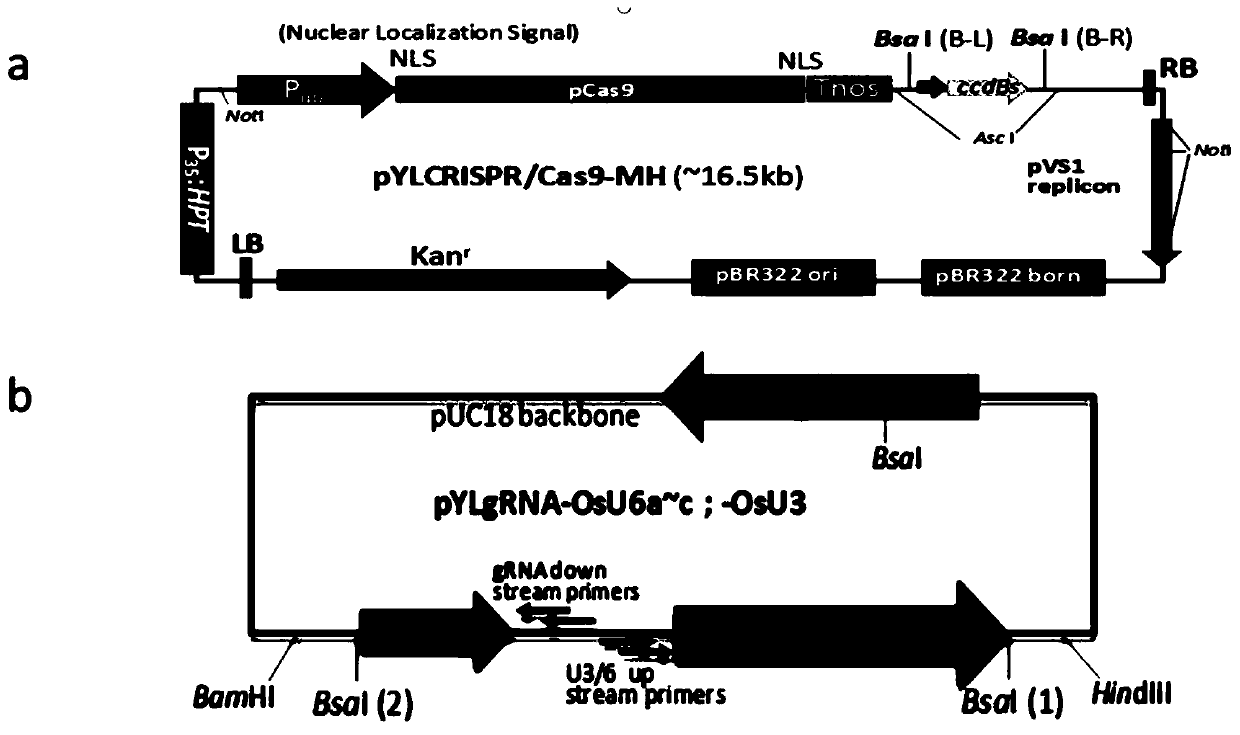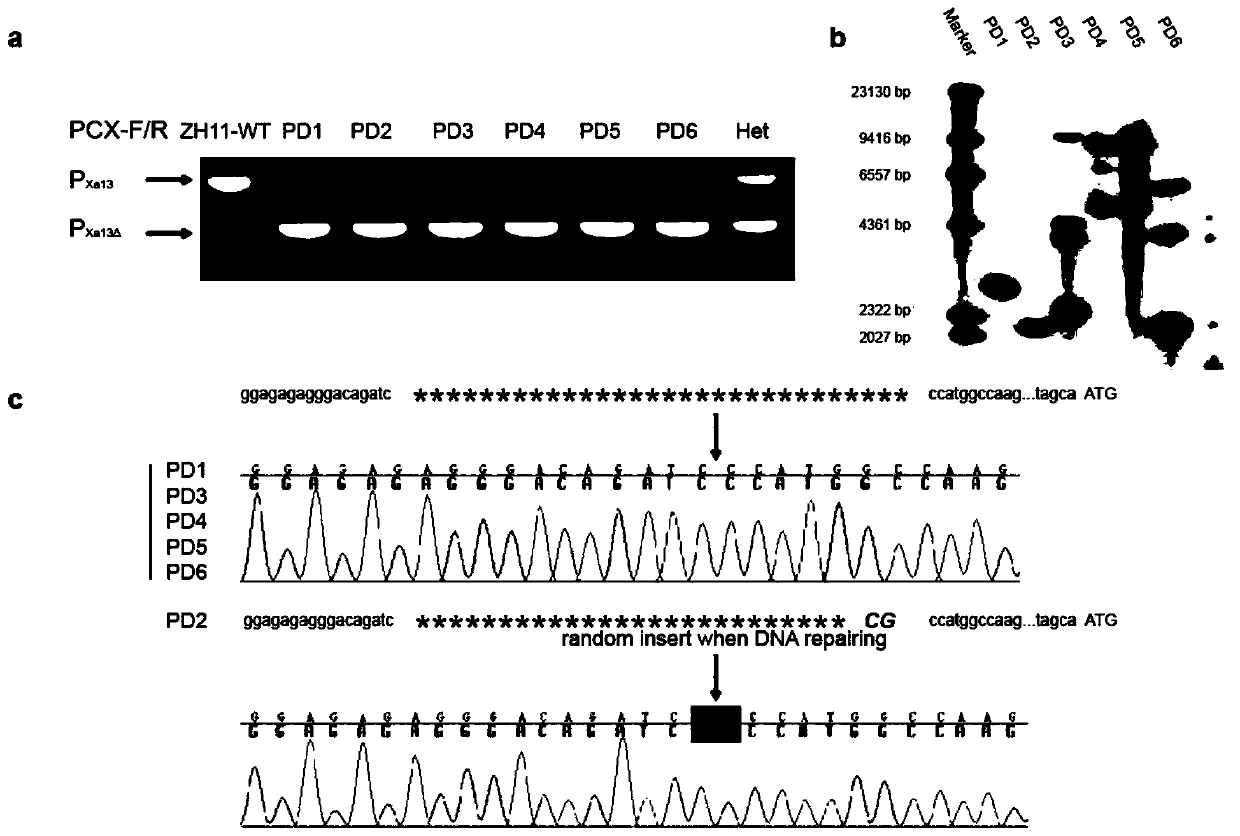SigRNAs specifically shearing rice xal3 gene promoter using CRISPR/Cas9 system and its application
A promoter and specific technology, applied in the field of sgRNA, can solve the problems of decreased pollen fertility and expression, and achieve the effect of good fertility and no trace of transgenic
- Summary
- Abstract
- Description
- Claims
- Application Information
AI Technical Summary
Problems solved by technology
Method used
Image
Examples
Embodiment 1
[0043] Selection of Cas9 target and construction of Cas9+P13(g1RNA+g2RNA) expression vector
[0044] According to the literature published by Chu et al. (2006), the sequence number "DQ421395" of the Xa13 gene in Genebank was obtained. The sequence of DQ421395 was obtained in the Genebank of the NCBI website (www.ncbi.nlm.nih.gov) according to this sequence number. Perform blastn on the TIGR Rice website (http: / / rice.plantbiology.msu.edu / LocusNameSearch.shtml) according to the sequence of DQ421395, and obtain its locus identifier in TIGR Rice: Os08g42350.1. 2000 bp forward from the 5' end of the gene was selected as its promoter sequence. Refer to the articles published by Romer (2010) and Yuan (2011) to obtain the sequence of elements in the promoter that are induced and regulated by pathogenic bacteria. A cas9 cleavage target site is selected at the upstream and downstream of the element sequence.
[0045] Referring to the method of Liu Yaoguang’s research group (Ma et al....
Embodiment 2
[0051] (1) Transformation of Cas9+P13(g1RNA+g2RNA) vector
[0052] Referring to the Agrobacterium-mediated indica rice transformation method published by Hiei et al. (1994), the constructed Cas9+P13 (g1RNA+g2RNA) expression vector was transformed into the commonly used japonica rice transformation variety ZH11. The PCR primer Hpt-F / R of hygromycin resistance gene was used for PCR positive screening of transgenic plants, and 40 independent positive transformed plants of T0 generation were obtained; 40 positive transformed plants were detected by PCX-F / R , it was found that 6 strains achieved complete cleavage of the target site.
[0053] (2) PCR sequencing verification of target sites in homozygous sheared transgenic plants
[0054] In order to prove that the deletion of the target genome sequence in this study is indeed caused by the specific cleavage mediated by Cas9 and two sgRNAs, this example uses PCX-F / R to amplify the PCR products obtained from transgenic plants, and cl...
Embodiment 3
[0060] Identification of bacterial blight resistance in transgenic rice with homozygous splicing of the target locus
[0061] In order to detect whether the transgenic plants have obtained the expected disease resistance, all T0 transgenic plants were inoculated with bacterial race PXO99 at the peak tillering stage in this embodiment (using turbidimetric method, the inoculation concentration was controlled at 9- 1.2 billion / ml). Each transgenic plant was inoculated with 5-6 leaves, and the lesion length and lesion area were observed 14 days after inoculation. See Table 2 for the inoculation results. In Table 2: the wild type Zhonghua 11 (ZH11) had obvious disease, the average leaf lesion length was 16.82cm, and the lesion area was 65.82%. The transgenic plants (PD1-PD6) showed significantly improved disease resistance. Calculated according to the standard adopted by Chu Zhaohui (2006) (14 days after inoculation, lesion length <3cm is high resistance level), transgenic T0 ge...
PUM
 Login to View More
Login to View More Abstract
Description
Claims
Application Information
 Login to View More
Login to View More - R&D
- Intellectual Property
- Life Sciences
- Materials
- Tech Scout
- Unparalleled Data Quality
- Higher Quality Content
- 60% Fewer Hallucinations
Browse by: Latest US Patents, China's latest patents, Technical Efficacy Thesaurus, Application Domain, Technology Topic, Popular Technical Reports.
© 2025 PatSnap. All rights reserved.Legal|Privacy policy|Modern Slavery Act Transparency Statement|Sitemap|About US| Contact US: help@patsnap.com



